![]()
![]()
![]()
Use LEFT and RIGHT arrow keys to navigate between flashcards;
Use UP and DOWN arrow keys to flip the card;
H to show hint;
A reads text to speech;
26 Cards in this Set
- Front
- Back
- 3rd side (hint)
|
FUNCTIONAL CHARACTERISTICS |
1. excitability: receive/respond to stimulus 2. contractility: can shorten 3. extensibility: can stetch beyond resting length 4. elasticity: resume resting length after stretched |
|
|
|
ANATOMY OF GROSS SKELETAL MUSCLE |
1. deep fascia 2. epimysium 3. fascicles 4. perimysium 5. endomysium 6. muscle fiber 7. sarcolemma 8. sarcoplasm a. glycogen b. myoglobin c. mitochondria d. myofibril I. I band, Z disc, A band II. sarcomere (i). myosin filament (ii). myosin binding head |
|
|
|
1. DEEP FASCIA |
- tissue covering muscle |
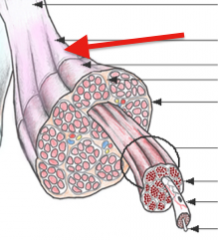
|
|
|
2. EPIMYSIUM |
- dense irregular connective tissue - encases all structures in individual muscle |
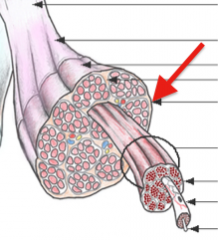
|
|
|
3. FASCICLES |
- bundles of muscle fibers in indentifiable muscle - encased by perimysium... |
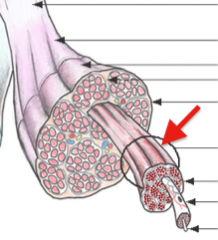
|
|
|
4. PERIMYSIUM |
- collagen sheath - encases each fascicle - bundles muscle fibers together to form a fascicle "encases PERIMeter" |
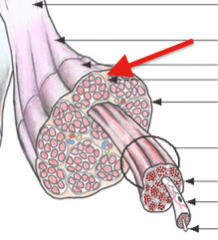
|
|
|
5. ENDOMYSIUM |
- tissue rich in reticular fibers - encase each muscle fiber... |

|
|
|
6. MUSCLE FIBER |
- contractile cell within muscle - multinucleated - each muscle cells has a lot of nuclei * muscle fiber = muscle cell |
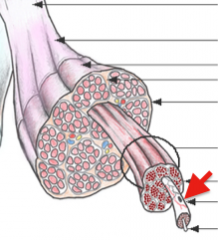
|
|
|
7. SARCOLEMMA |
- plasma membrane of muscle cell |
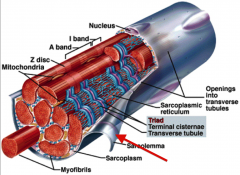
|
|
|
8. SARCOPLASM |
- cytoplasm of muscle cell |

|
|
|
8a. GLYCOGEN |
- stored energy - within sarcoplasm of muscle cell - muscle cell works hard during contraction - requires lots of energy - needs to store alot for repetitive contractions - needs oxygen when metabolizing glyco to produce energy |
|
|
|
8b. MYOGLOBIN |
- oxygen-binding protein - need oxygen for energy! - muscle cell works hard - draws energy from carb glycogen - if oxygen isn't present @ time glycogen is metabolized -- little energy produced :( - needs to store alot of oxygen for when glycogen is metabolized so alot of energy can be produced |
|
|
|
8c. MITOCHONDRIA |
- organelle in muscle cell - aerobic metabolism yields energy from mito |
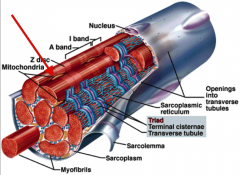
|
|
|
8d. MYOFIBRIL |
- organelle in muscle fiber's sarcoplasm - chains of sarcomeres.. below - contractile component of muscle fiber - arranged parallel to longitudinal axis of muscle - has repeating dark & light colored areas... I, Z, A |
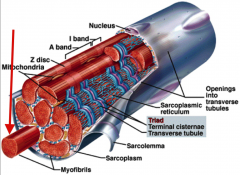
|
|
|
8d.I. I BAND, Z DISC, A BAND |
I BAND: - lighter colored band Z DISC: - mid substance of I band - located in periphery of sarcomere A BAND: - darker colored bands |
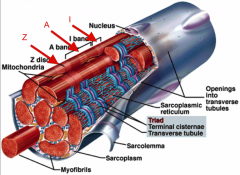
|
|
|
8d.II. SARCOMERE |
- region of myofibril - between successive Z discs - chains of sarcomeres make up myofibril - contractile unit of myofibril |

|
|
|
8d.II.MYOSIN FILAMENT (thick filament) |
- protein - anchored in middle of sarcomere - extends toward Z discs - contains binding heads that are closer to Z's |

|
|
|
8d.II. MYOSIN BINDING HEAD |
- resting posture = bent - location for ATPase enzyme - ATPase breaks down ATP --> ADP+Pi+Energy - myosin binding head uses ^ released energy to assume erect posture - in high energy state, heads extend toward the globular actin.. (later) |
|
|
|
8d.II. ACTIN FILAMENT (thin filament) |
- binding site for myosin binding heads - anchored in Z discs - entends towards middle of sarcomere contains: 1. globular actin 2. tropomyosin 3. troponin complex |
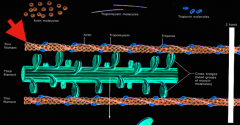
|
|
|
8d.II. GLOBULAR ACTIN |
- active sites - during muscle contraction binding heads attach here |
|
|
|
8d.II. TROPOMYOSIN |
- rod shaped protein - coils around globular actin - stiffens actin filament - helps block globular actin binding sites from myosin binding heads during times of relaxation - serves as backbone of actin filament - allows it to resist tensile force |
|
|
|
8d.II. TROPONIN COMPLEX |
- made of 3 specialized structures: 1. TnI 2. TnT 3. TnC |
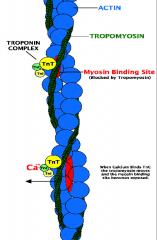
|
|
|
1. TnI |
- troponin inhibitor - helps totally block globular actin binding sites |
|
|
|
2. TnT |
- troponin tropomyosin - binds troponin complex w. tropomyosin |
|
|
|
3. TnC |
- troponin calcium - where calcium will bind - if calcium's present in sarcomere... - travels to TnC, is bound, enlarges, + changes shape - new shape allows it to keep inhibitor away from globular actin so that there are available binding sites for binding heads |
|
|
|
STILL NEED TO DO: SLIDING FILAMENT THEORY & ALL OR NONE PRINCIPLE !!!!!!!!!!!!!!!!!!!!!!!!!!!!!!!!!!!!! |
|
|

